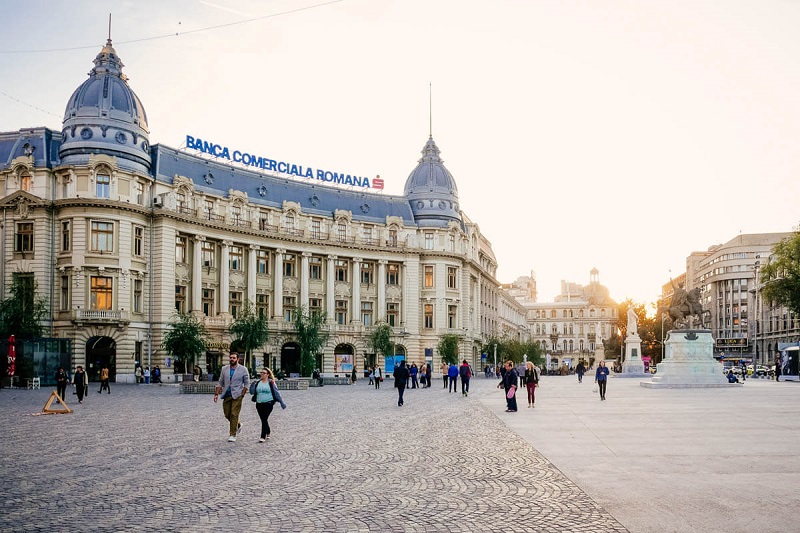Think staying in Europe over 90 days is just for the locals? I’ll take you through exactly how to get a Schengen visa, how to extend it (legally) and which countries you can do that in. Plus, the guide will walk you through volunteering, studying and more in the EU with a Schengen visa. Passports at the ready!
Staying in Europe over 90 days – and how to maximise your Schengen visa
Schengen visa validity period and duration of stay
Sunning yourself on a Mediterranean beach, strolling through Paris – it can all be yours, with a Schengen visa.
It’s a visa that lets you visit Europe for a short stay of up to 90 days, to work or holiday.
Some nationalities will receive this automatically on entering the EU and others will need to apply before they arrive.
Either way, you can only stay for 90 days out of any 180 day period, so it’s crucial that you start tracking time on your phone’s calendar and stay within the rules.
How long can a US citizen stay in Europe?
The quick answer is 90 days, within a 180 day period- and no, it doesn’t simply reset if you leave the Schengen.
But – it’s a little known fact that due to an agreement between the two countries, you can actually stay much longer in France. You’ll be able to stay for a whole 180 days in France. Eiffel Tower, anyone?
[bctt tweet=”All you need to satisfy your curiosity – staying in the Schengen area (Europe) for more than 90 days! #Europe #worldtravel #TTOT #travelthoughts” username=”live10countries”]
Getting a Schengen visa – how to ace it
What exactly is it like applying for a Schengen tourist visa for non EU nationals?
Helene from www.masalaherb.com explains her experience:
How can you get an Schengen visa for a partner who is not European?
I’m Austrian and my husband is an Indian national. When we travelled together to Austria for the first time, we got a Schengen visa for my husband. We really wanted to avoid a no visa situation as this is something that can happen to people with a weak passport.
So we kept everything ready, including the filled out application, the passport sized pictures, a travel insurance, proof of accommodation, paid visa and the most difficult of the lot, the proof of financial means.
For the financial means we filled income tax for my husband’s business incomes, plus we had bank statements, which show the last 6 months balance. The point of this is to show that you can support yourself and that you will not fall back and turn into a burden to the Schengen country/countries. You can also add proof of prepaid transport and accommodation.
A letter of invitation from a friend or relative (if you intend to stay with them) in the Schengen area can also be helpful.
Should you use an agency for your application?
For the next step we decided to work with an agency. The agency was specialized in sending in the documents to the embassy and at the time we found it to be the easiest solution.
You don’t need to look up an agency, but it’s good to know that it is an option as they can guide you along the way. The earliest you can apply is 3 months in advance and the latest 15 days before your trip.
Eventually, the embassy will call you for an interview. You need to attend in person and you absolutely have to be on time. After the interview it usually takes about 15 days until you get your Schengen visa and with that you can enter the Schengen area for the period of your visa. The visa was important for us because this was my opportunity to introduce my husband to my family in Austria and in other Schengen countries.
————————————————————————————-
Can you volunteer on a Schengen visa and stay in the Schengen zone for 90 days?
Looking for a working holiday in Europe? If you’re doing unpaid work (volunteering) you can still have an incredible experience and plenty of great bonuses – like free accommodation. The Schengen visa could be exactly what you need to do that, and here you can read all about working holidays in other countries.
Erin from https://curiouslyerin.com/ explains her experience:
I have been lucky enough to spend the past winter volunteering in Slovakia at a ski resort. As Slovakia is part of the Schengen, I was only allowed to stay a maximum of 90 days out of any 180 days.
Being an Australian, I didn’t need to pre-arrange any visas, I just arrived. I had pre-arranged this volunteer programme through the online platform Workaway. After a few emails back and forth I was accepted into the Workaway programme that was based in Jasna Ski Resort, Slovakia.
What documents do you need to volunteer in the Schengen?
As per legal requirements for volunteers, I needed to sign a contract that was to protect me and ensure I received the agreed benefits.
The programme I joined was absolutely incredible. My specific duties were to help at the children’s ski school. I would assist the instructors in the warm-up activities with kids aged between 3 and 12, I would wear the bear mascot outfit (which the kids would go crazy for), make tea and keep the kids’ room clean. I worked from 9.45am until 1.30pm, 5 days a week.
What I got in return was free accommodation in a budget hotel a half hour drive from the mountain, a local bus pass, three meals a day, ski rental equipment, a season lift pass, access to the aqua park and a further 50% off food and drinks on the mountain.
I left before the season ended to ensure I didn’t overstay my 90 days. I am now travelling through non-Schengen countries and looking forward to re-entering the Schengen again once another 90 days is up.
——————————————————————————————————————-
Can US citizens study in Europe on a Schengen visa?
Jamie from https://crashedculture.com/ explains her experience.
How can US citizens get a Schengen student visa?
Once I got settled in Spain, I had to apply for a resident card within my first 90 days, which was as long as my student visa was good for. This part was a bit less stressful, though it did involve taking the metro out to the boondocks and standing in line all morning, hoping that I had all the documents I needed.
How can you become resident in Spain?
How can get a long term Schengen visa?
Bit of a shame, but you can’t get a longer version of the standard 90 day tourist Schengen visa.
Instead, you can get a longer visa issued by the specific European country you’re visiting, and that gains you entry to the rest of the Schengen.
For that, you’ll need all the usual documents and an appointment with your consulate.
The best country to do this in, rumour has it, is France. France has a great selection of visas that allow international travellers to extend their stay.
Other options with shorter visa wait times would be: Italy, Germany and Spain.
How do I go about staying in europe over 90 days? And which country is the best for that?
You’ll need to split time between the Schengen area and at least one non-Schengen country.
Here are some of them – and some reasons why you might choose them.
- Romania – read what that’s like below
- Ukraine
- Croatia – the cost of living here might be an advantage
- the UK – this is an island, but the Eurostar high speed train makes it easy to reach London
Shimona from https://www.sidecarphoto.co/ explains her experience:
In the autumn of 2017, I lived and worked in Bucharest, Romania for 4 months, during which I naturally took great advantage of its proximity to the rest of Europe. I had a working visa for Romania, but my husband was on a tourist visa. Now, Romania isn’t part of the Schengen Zone but every other weekend, my husband and I bounced over to a Schengen Zone country to visit cities like Prague, Athens, Venice, Madrid, Lisbon… the list goes on. So we were also managing our Schengen tourist visas at the same time.
If you’re close to running out of days within the Schengen zone, you can do the opposite and head to a non-Schengen Zone country, such as Romania, Georgia and Croatia, all of which are lovely places to visit.
How exactly can you use visits to non Schengen countries to stay longer?
The Schengen visa gives you 90 days out of every 180 and you don’t reset every time you leave and re-enter. The same is true of the Romanian tourist visa. To keep track of our days, we made a spreadsheet in Google Sheets to make sure we didn’t overstay. One key tip – Remember that your travel days do count at both ends. So if you arrive on a Monday and leave the next Monday, that’s eight days, not seven.
What’s it like staying in Europe over 90 days?
Since we were only travelling weekends, we weren’t in much danger of overstaying in the Schengen Zone, but rather of overstaying in Romania. My work visa was more flexible but my husband had the 90 day visa and he headed to Berlin for 10 days when he was getting close to his limit in Romania.
——————————————————————————————————————————–
Which countries find it the hardest to get a Schengen visa?
Although getting the visa should be a simple process, at times your travel history and the status of your passport may complicate things.
Lavdi from http://kosovogirltravels.com/ explains her experience:
Being a Kosovan citizen means I cannot travel visa-free to the European Union countries but I have to apply for a Schengen visa every time I plan to be in the Schengen zone.
What is the visa application process like?
Initially, I need to contact the embassy of the country I’m planning to go to if there is one in my country or check online to understand the application process. For some countries I can apply online, some others through an agency, and for others I’d have to go to Skopje, Macedonia or Tirana, Albania.
The second step in the process is to collect all the necessary papers – birth certificate, family certificate, flight ticket, hotel reservation/invitation letter, bank statement, two pictures, payment of the visa fee (at times done in cash at the embassy premises), and a work contract.
Then, when your interview appointment is scheduled (which usually takes place after two months or so depending on which embassy you are applying in), you go there and are questioned – and at times it feels like being interrogated – and then told to go in two weeks time to get your response.
What are some of the challenges with applying for a visa from these countries?
When I applied for a Schengen visa to go to Thessaloniki, Greece last year for a long weekend, the Greek Liaison Office in Pristina gave me only a three-month visa with 21 days available to spend in the Schengen zone. Despite it being the second visa issued by this office and being my fifth visa on the passport and about my 15th visa in total in the past 10 years – including a valid three-year US visa – 21 days is all I got from the Greek office.
Moreover, I only got my answer the day before I planned to leave so I still had to run home and get ready and leave the next morning. Nevertheless, I managed to get ready for the next morning and had a fabulous time in Thessaloniki. I used that visa and those 21 days to the maximum and later during the year went to Croatia, Germany, and Slovenia.
Where can I find a specialist agency?
After reading all of these accounts, you may be thinking you need to work with a professional! Google is a great place to start your search. Make sure they are familiar with both your home nationality and getting travellers successfully into the Schengen.
If you´re searching for immigration and migration advice from a London-based agent, IaM may be able to help. You can complete the Schengen visa application information online through their site, with them checking everything is correct, coordinating with you and helping you secure an appointment about your visa (not such an easy thing!). And payments are fully refundable if your travel arrangements cannot be met, so you have peace of mind. If you choose a premium appointment, for certain countries, there is also assistance at the consulate, embassy or VAC.

- The Enchanted Glade Glamping Review - April 23, 2024
- How to get a working holiday visa for the UK – a full guide - March 21, 2024
- Panoramic Pods Allendale Glamping Review - February 15, 2024







As an American, can you leave the eu for 90 days and return traveling to a non-eu country, say Vietnam, and never return to the USA?